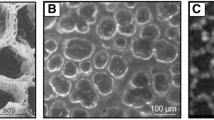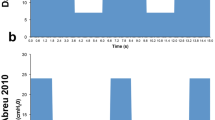Abstract
Management of ALI/ARDS involves supportive ventilation at low tidal volumes (V t) to minimize the rate at which ventilator induced lung injury (VILI) develops while the lungs heal. However, we currently have few details to guide the minimization of VILI in the ALI/ARDS patient. The goal of the present study was to determine how VILI progresses with time as a function of the manner in which the lung is ventilated in mice. We found that the progression of VILI caused by over-ventilating the lung at a positive end-expiratory pressure of zero is accompanied by progressive increases in lung stiffness as well as the rate at which the lung derecruits over time. We were able to accurately recapitulate these findings in a computational model that attributes changes in the dynamics of recruitment and derecruitment to two populations of lung units. One population closes over a time scale of minutes following a recruitment maneuver and the second closes in a matter of seconds or less, with the relative sizes of the two populations changing as VILI develops. This computational model serves as a basis from which to link the progression of VILI to changes in lung mechanical function.








Similar content being viewed by others
References
The Acute Respiratory Distress Syndrome Network. Ventilation with lower tidal volumes as compared with traditional tidal volumes for acute lung injury and the acute respiratory distress syndrome. N. Engl. J. Med. 342:1301–1308, 2000.
Albert, S. P., J. DiRocco, G. B. Allen, J. H. T. Bates, R. Lafollette, B. D. Kubiak, J. Fischer, S. Maroney, and G. F. Nieman. The role of time and pressure on alveolar recruitment. J. Appl. Physiol. 106:757–765, 2009.
Allen, G., and J. H. Bates. Dynamic mechanical consequences of deep inflation in mice depend on type and degree of lung injury. J. Appl. Physiol. 96:293–300, 2004.
Allen, G., L. K. Lundblad, P. Parsons, and J. H. Bates. Transient mechanical benefits of a deep inflation in the injured mouse lung. J. Appl. Physiol. 93:1709–1715, 2002.
Allen, G. B., T. Leclair, M. Cloutier, J. Thompson-Figueroa, and J. H. Bates. The response to recruitment worsens with progression of lung injury and fibrin accumulation in a mouse model of acid aspiration. Am. J. Physiol. Lung Cell. Mol. Physiol. 292:L1580–L1589, 2007.
Bates, J. H. T. Lung Mechanics. An Inverse Modeling Approach. Cambridge: Cambridge University Press, 2009.
Bates, J. H. T., and C. G. Irvin. Time dependence of recruitment and derecruitment in the lung: a theoretical model. J. Appl. Physiol. 93:705–713, 2002.
Cassidy, K. J., D. Halpern, B. G. Ressler, and J. B. Grotberg. Surfactant effects in model airway closure experiments. J. Appl. Physiol. 87:415–427, 1999.
Crotti, S., D. Mascheroni, P. Caironi, P. Pelosi, G. Ronzoni, M. Mondino, J. J. Marini, and L. Gattinoni. Recruitment and derecruitment during acute respiratory failure: a clinical study. Am. J. Respir. Crit. Care Med. 164:131–140, 2001.
Fuchimukai, T., T. Fujiwara, A. Takahashi, and G. Enhorning. Artificial pulmonary surfactant inhibited by proteins. J. Appl. Physiol. 62:429–437, 1987.
Fujioka, H., and J. B. Grotberg. Steady propagation of a liquid plug in a 2D-channel. J. Biomech. Eng. 126:567–577, 2004.
Fujioka, H., and J. B. Grotberg. Steady propagation of a surfactant laden liquid plug in a 2D-channel. Phys. Fluids 17:Art. No. 082102, 2005.
Gaver, III, D. P., D. Halpern, O. E. Jensen, and J. B. Grotberg. The steady motion of a semi-infinite bubble through a flexible-walled channel. J. Fluid Mech. 319:25–65, 1996.
Gaver, III, D. P., R. W. Samsel, and J. Solway. Effects of surface tension and viscosity on airway reopening. J. Appl. Physiol. 69:74–85, 1990.
Halpern, D., and J. B. Grotberg. Surfactant effects on fluid-elastic instabilities of liquid-lined flexible tubes. J. Fluid Mech. 244:615–632, 1993.
Hantos, Z., B. Daroczy, B. Suki, S. Nagy, and J. J. Fredberg. Input impedance and peripheral inhomogeneity of dog lungs. J. Appl. Physiol. 72:168–178, 1992.
Heil, M. Airway closure: occluding liquid bridges in strongly buckled elastic tubes. J. Biomech. Eng. 121:487–493, 1999.
Holm, B. A., and R. H. Notter. Effects of hemoglobin and cell-membrane lipids on pulmonary surfactant activity. J. Appl. Physiol. 63:1434–1442, 1987.
Holm, B. A., R. H. Notter, and J. N. Finkelstein. Surface property changes from interactions of albumin with natural lung surfactant and extracted lung lipids. Chem. Phys. Lipids 38:287–298, 1985.
Howell, P. D., S. L. Waters, and J. B. Grotberg. The propagation of a liquid bolus along a liquid-lined flexible tube. J. Fluid Mech. 406:309–335, 2000.
Ma, B., and J. H. T. Bates. Modeling the complex dynamics of derecruitment in the lung. Ann. Biomed. Eng. 38:3466–3477, 2010.
Massa, C. B., G. B. Allen, and J. H. T. Bates. Modeling the dynamics of recruitment and derecruitment in mice with acute lung injury. J. Appl. Physiol. 105:1813–1821, 2008.
Matthay, M. A., S. Bhattacharya, D. Gaver, L. B. Ware, L. H. Lim, O. Syrkina, F. Eyal, and R. Hubmayr. Ventilator-induced lung injury: in vivo and in vitro mechanisms. Am. J. Physiol. Lung Cell. Mol. Physiol. 283:L678–L682, 2002.
Matthay, M. A., L. B. Ware, and G. A. Zimmerman. The acute respiratory distress syndrome. J. Clin. Investig. 122:2731–2740, 2012.
Naureckas, E. T., C. A. Dawson, B. S. Gerber, D. P. Gaver, III, H. L. Gerber, J. H. Linehan, J. Solway, and R. W. Samsel. Airway reopening pressure in isolated rat lungs. J. Appl. Physiol. 75:1323–1333, 1994.
Nelder, J. A., and R. Mead. A simplex method for function minimization. Comput. J. 7:308–313, 1965.
Pavone, L., S. Albert, J. DiRocco, L. Gatto, and G. Nieman. Alveolar instability caused by mechanical ventilation initially damages the nondependent normal lung. Crit. Care 11:R104, 2007.
Pavone, L. A., S. Albert, D. Carney, L. A. Gatto, J. M. Halter, and G. F. Nieman. Injurious mechanical ventilation in the normal lung causes a progressive pathologic change in dynamic alveolar mechanics. Crit. Care 11:1–9, 2007.
Pelosi, P., M. Goldner, A. McKibben, A. Adams, G. Eccher, P. Caironi, S. Losappio, L. Gattinoni, and J. J. Marini. Recruitment and derecruitment during acute respiratory failure: an experimental study. Am. J. Respir. Crit. Care 164:122–130, 2001.
Perun, M. L., and D. P. Gaver III. An experimental model investigation of the opening of a collapsed untethered pulmonary airway. J. Biomech. Eng. 117:245–253, 1995.
Perun, M. L., and D. P. Gaver III. The interaction between airway lining fluid forces and parenchymal tethering during pulmonary airway reopening. J. Appl. Physiol. 75:1717–1728, 1995.
Salazar, E., and J. H. Knowles. An analysis of pressure-volume characteristics of the lungs. J. Appl. Physiol. 19:97–104, 1964.
Schuessler, T. F., and J. H. Bates. A computer-controlled research ventilator for small animals: design and evaluation. IEEE Trans. Biomed. Eng. 42:860–866, 1995.
Seah, A. S., K. A. Grant, M. Aliyeva, G. B. Allen, and J. H. T. Bates. Quantifying the roles of tidal volume and PEEP in the pathogenesis of ventilator-induced lung injury. Ann. Biomed. Eng. 39:1505–1516, 2011.
Seeger, W., G. Stohr, H. R. D. Wolf, and H. Neuhof. Alteration of surfactant function due to protein leakage—special interaction with fibrin monomer. J. Appl. Physiol. 58:326–338, 1985.
Smith, B. J., E. Yamaguchi, and D. P. Gaver III. A translating stage system for μ-PIV measurements surrounding the tip of a migrating semi-infinite bubble. Meas. Sci. Technol. 21:015401, 2010.
Zheng, Y., J. C. Anderson, V. Suresh, and J. B. Grotberg. Effect of gravity on liquid plug transport through an airway bifurcation model. J. Biomech. Eng. Trans. ASME 127:798–806, 2005.
Zheng, Y., H. Fujioka, J. C. Grotberg, and J. B. Grotberg. Effects of inertia and gravity on liquid plug splitting at a bifurcation. J. Biomech. Eng. 128:707–716, 2006.
Acknowledgments
This work was supported by NIH grants P30 GM103532 and T32 HL076122. Computational resources were provided by the Vermont Advanced Computing Core which is supported by NASA NNX-08AO96G.
Author information
Authors and Affiliations
Corresponding author
Additional information
Associate Editor John H. Linehan oversaw the review of this article.
Rights and permissions
About this article
Cite this article
Smith, B.J., Grant, K.A. & Bates, J.H.T. Linking the Development of Ventilator-Induced Injury to Mechanical Function in the Lung. Ann Biomed Eng 41, 527–536 (2013). https://doi.org/10.1007/s10439-012-0693-2
Received:
Accepted:
Published:
Issue Date:
DOI: https://doi.org/10.1007/s10439-012-0693-2




